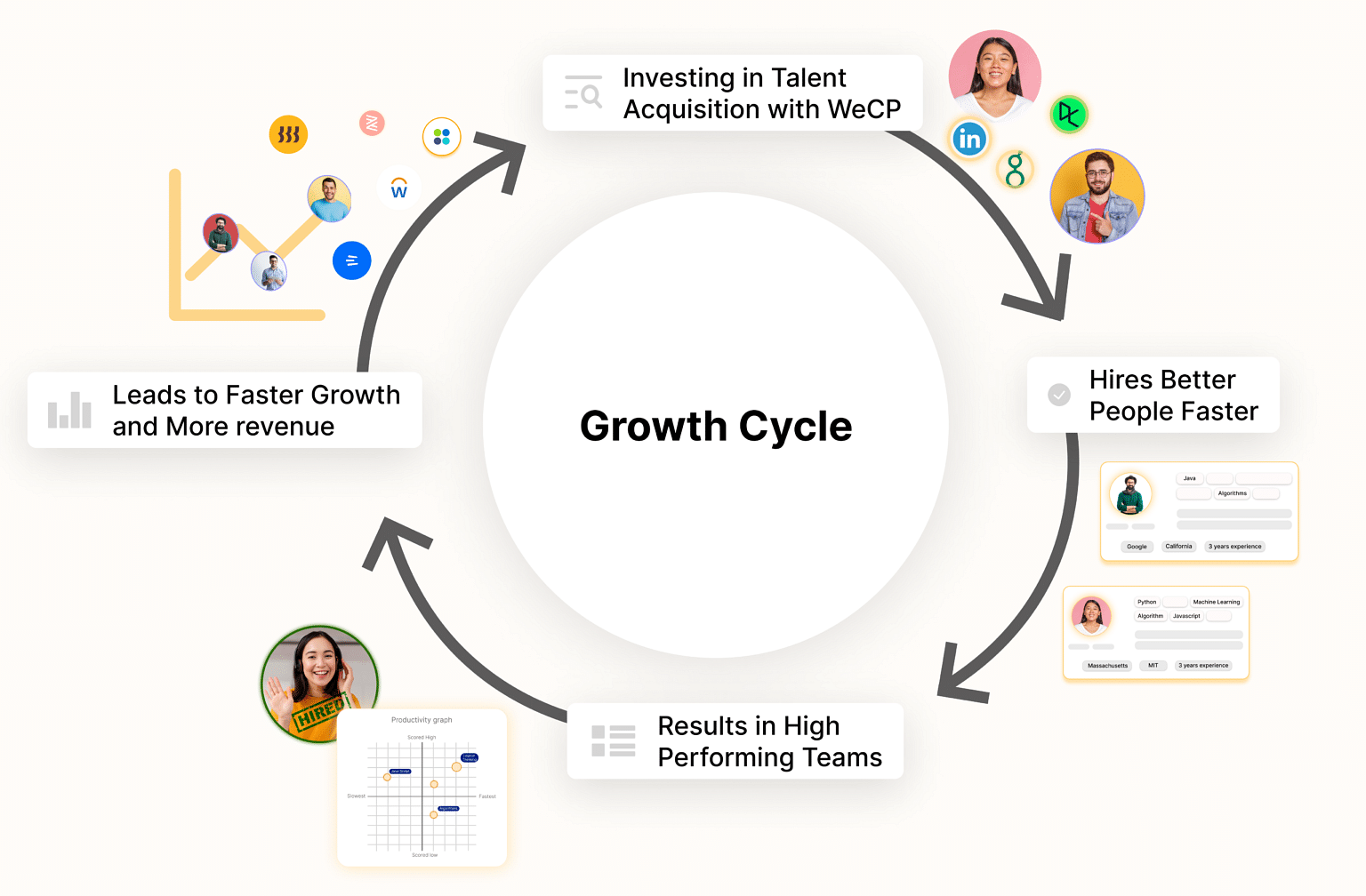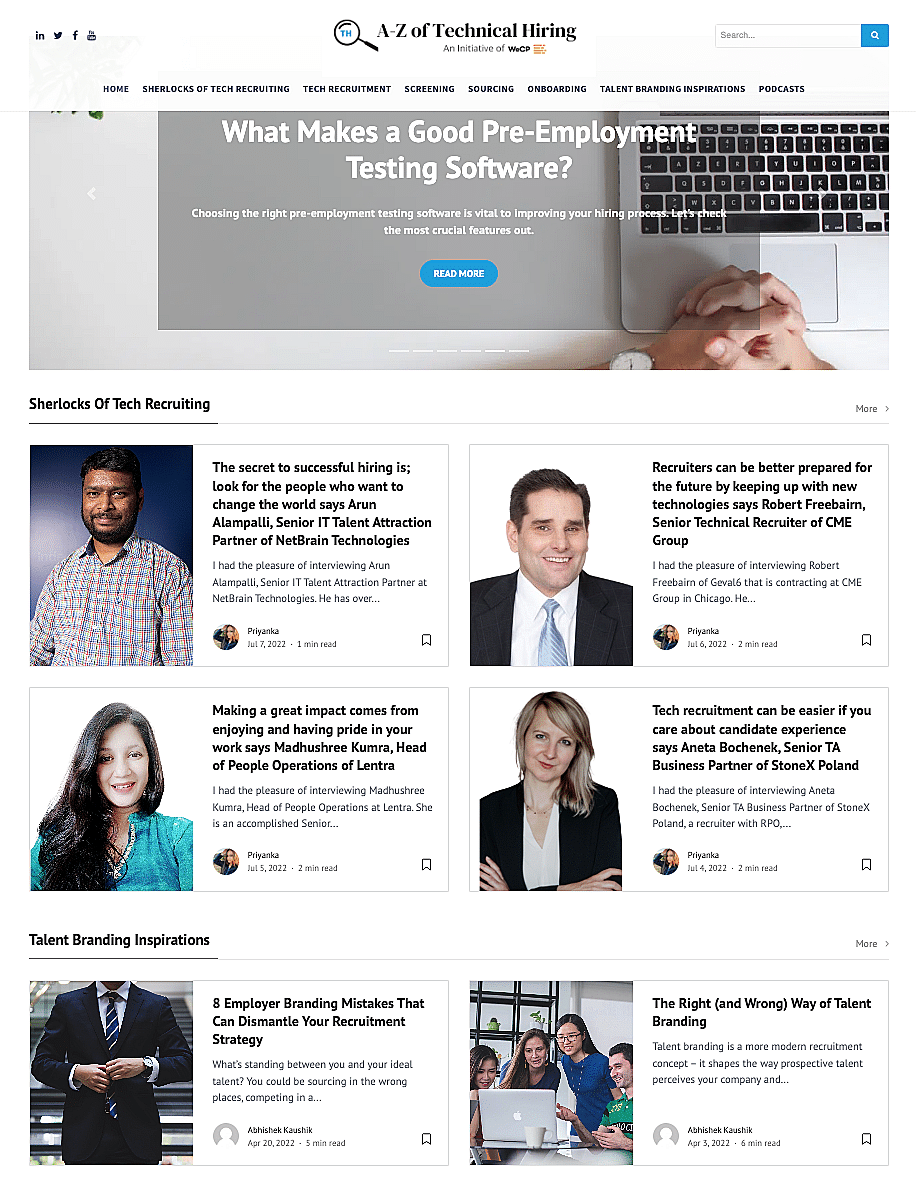
Growing WeCP as a brand: CEO Abhishek Kaushik on hiring, building a community, and creating content around pain points
By Jim James, Founder EASTWEST PR and Host of The UnNoticed Entrepreneur.
Bangalore, India-based Abhishek Kaushik is the Chief Executive Officer and Co-Founder of We Create Problems (WeCP). He joined me in the recent episode of The UnNoticed Entrepreneur to talk about how and why he built a million-strong community to help grow his business.
Image from LinkedIn
What is We Create Problems?
WeCP is a technical hiring software. They help talent acquisition leaders screen candidates by giving coding assignments and projects and asking technical questions. They also aid in conducting face-to-face interviews and onboarding qualified applicants instantly.
Essentially, what they do is streamline the entire technical hiring process.
Image from WeCP
Abhishek and co-founder Mohit Goyal started conceptualising the business when they were college students back in 2015. Now, they’ve got Microsoft and other blue chip companies as their clients.
One of the approaches that they used in building their brand is through referrals. They’ve talked to their customers and asked about the reason they trust and like WeCP. And if they do like the brand, they’d request for that customer to refer them to their colleagues and other people in their professional network.
From their first customer, they were able to get their second customer. From their second customer, they were able to get their third customer. Their fourth customer was a referral from their first customer.
Most of their customers have come from referrals. This was what they initially did before they recently started spending more on marketing to further boost their brand.
On Running the Technical Hiring Community
WeCP is running www.technical-hiring.com, which is a community of technical hiring leaders across the world. The objective of building this community is to educate hiring leaders and engage with senior leaders in the industry so they can share their knowledge and experience.
Through this community, WeCP wants to empower people to learn more about technical hiring. What inspired them to do it is Canva. The company has empowered everybody to design — you no longer need to depend on a designer to publish visual assets. In that same manner, Abhishek thinks that recruiters also don’t need to depend on hiring managers to hire engineers. You can learn also how to hire engineers using simple basic math; you don’t have to be an engineer to be able to do so.
Screengrab from Technical Hiring
Looking at today’s data, nearly 40% of the engineering hours of a company are spent on hiring engineers — not shipping products or writing codes. And that is a massive time that hiring managers and their teams are spending on sketching plans for hiring new people and interviewing them.
This is why WeCP wants to break the status quo. If you want to hire engineers, 95% of the work can be done by recruiting solutions like theirs and your hiring managers would only need to take care of the remaining 5%.
Apart from being time-consuming, about 39% of business revenue is also lost because it is the engineers who are involved in hiring engineers. At WeCP, they believe that engineering hiring can be deliberately handed over from engineers to the recruitment team.
Clever Content Creation
WeCP went to Hacker News, GitHub, and the like to understand the real problems when it comes to hiring engineers. Then, they populated the problems on a simple Google Sheet and started identifying the pain points and drafting articles around those. They also interviewed people and others who have solved such problems. They collated these solutions and matched them with the appropriate pain points.
This was how they started writing their first blog.
Their initial blogs were done by discovering problems and asking experts how they could be solved. Because back then, they were a very young team. After some time, they also started learning about technical hiring.
Fast forward to today, their blog — which now has more than 200 articles about technical hiring and recruiting — has already earned massive subscribers.
The idea behind their blog is rather simple: Pick a problem, fundamentally go through solutions, and then explain it in a simple manner to their audience. This is how they’re able to generate a lot of leads via their content. Every day, roughly five to eight marketing qualified leads (MQLs) are generated through their content.
A couple of months ago, they also started doing paid advertising on LinkedIn. They’ve also begun giving free ebooks and white papers to their audience and community. They’ve also been handing out checklists and more assets like that to help others with their technical hiring needs.
What they also did is to connect their LinkedIn to Hubspot. Every time somebody downloads an ebook or a white paper, it’s automatically reflected on their HubSpot account. They use that information to engage with their leads through email campaigns among others.
Understanding Customers and Users Better
Abhishek and his team go to GitHub and other verticals where their audience lives to look into problems that their audience faces.
Image from Unsplash
One of their strategies in identifying those pain points in their market is to figure out where their customers are dissatisfied with their competitors. They also look into review sites to know whether their competitors were given a bad review. And they research to find out more about the reasons that prompted their customers to leave that kind of review. What kind of problems did other vendors fail to solve for their customers?
Based on their findings, they build essential topic clusters and write content around those. And these contents gained good traction, especially from the people who wrote about those topics. Then, they invite those people to join them on a call so they can further learn how WeCP’s solution can solve their problems.
Apart from that, they also began to understand the technology and industry trends toward hiring. What’s the typical process in a company? What’s that one thing that a user of their software really needs? What would that user lose if they don’t hit their recruitment goal? They’re taking the time to know what was going through their users’ minds so they could better understand and create categorised content based on these needs:
-
Functional needs. If a head of talent acquisition wants to hire engineers, their functional need would be to fill, for example, 50 engineering positions.
-
Social needs. Their social need would be to have somebody from their organisation share on a platform like LinkedIn that they were able to hit their target recruitment number. They want to be given a pat on the back and have their achievement acknowledged.
-
Emotional needs. Their emotional need would be to be happy throughout the recruitment process and not experience frustration or distress while achieving their functional needs. This need prompts WeCP to emphasise that you can successfully hire engineers through their software while remaining happy and sleeping peacefully.
Their Key Marketing Strategies
Currently, WeCP is in the process of expanding their business in Singapore, the US, and the UK and mirroring in these places what’s happening in India. As they’re expanding, they’re also trying to hire new people in these new demographics to help them achieve true customer acquisition — which, for them, is what happens when your customers are able to bring you more customers.
While they rely a lot on their customers’ trust to build their customers’ channels, they also have three simple marketing strategies to do that at scale: positioning, lead generation, and branding. They believe that better positioning leads to better leads; better leads lead to better brands.
As their plan now is to grow globally, they’re working on their positioning (both their content and visual positioning) to match their expansion. They are also doubling down on their lead generation.
As for branding, they believe that it is not about what they talk about to customers but what customers talk about them. This is why they are creating a branding strategy where they want customers to share their stories and the benefits of using their tool with their network using their own social media handles (Many of their customers have actually already done this in the past).
Image from Unsplash
Keep in mind that your customers want to be your friend. They want to work with people who they can reach out to and get help from to solve certain problems — which, in the first place, should be the same problems as what you’re trying to solve.
WeCP aspires to be friends with their customers by getting to know them well. And a customer is a great customer when they’re sharing their problems with you even when you’re not asking about those.
They build relations with their customers in two ways: business relations and product relations (where they’re adding emotions to their products as well). Then, it’s a matter of reminding and emotionally asking their customers about writing a review for them. For instance, they would say, “It’s been 18 months working with you and our people have dedicated 400 hours of work, blood, and sweat for you.”
Their strategy involves recounting the story of that customer with them, making a video to show them the real thing behind their hard work, and asking the customer to share that story on their handles.
To learn more about WeCP, visit www.wecreateproblems.com.
This article is based on a transcript from my podcast The UnNoticed Entrepreneur, you can listen here.
Cover image by Jason Goodman on Unsplash






